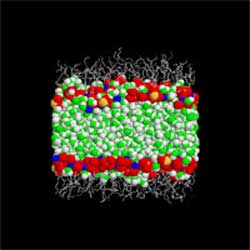UAB scientists discover the origin of a mysterious physical force

Discovery will led to improvements in the chemical, pharmaceutical and food industry
Ever since the 1970s, scientists have been trying to establish the cause of a repulsive force occurring between different electrostatically charged molecules, such as DNA and other biomolecules, when they are very close to each other in aqueous media. This force became know as hydration force.
Jordi Faraudo, a researcher for the Department of Physics at the Universitat Autònoma de Barcelona, and Fernando Bresme of the Department of Chemistry at Imperial College London have studied this mysterious force in detail and have discovered where its origins lie.
In the same way that a flag flutters in the direction the wind is blowing, at a microscopic level water molecules are gently attracted towards the direction in which an electric field is pointing. However, when the water is in contact with surfaces that create small electric fields, such as chemical compounds like those found in many detergents, this is no longer the case: the water molecules have a remarkable capacity to organise themselves into complex structures that are strongly orientated in such a way as to cancel out the electric field, and on some occasions, to reverse it. This abnormal behaviour was discovered by the same researchers and published in Physical Review Letters in April 2004.
The scientists have now discovered that this strange property is responsible for the hydration force that acts when water is surrounded by certain types of electrostatically charged molecules, such as DNA and some biological compounds, and when thin films form in detergents. The discovery has been published in today’s edition of Physical Review Letters.
Water is the solvent in which most physical, chemical and biological processes take place. Therefore, it is essential to understand the nature of interactions between molecules dissolved in water in order to understand many of these processes. Two of the most important of these processes are the adherence of substances to cell membranes and the withdrawal of proteins. Both of these are fundamental in biomedical research, since a substantial part of the process of designing new drugs is based on understanding how substances penetrate cell membranes to enter cells. These drugs are often proteins designed to prevent or strengthen the action of other substances. In these cases, accurately identifying the protein folding is essential, since the form these proteins take on when they fold influences how effectively they are able to act.
Fully understanding the properties of this force that occurs when molecules surrounded by water adhere to each other is also useful in the chemical industry, particularly when involving mechanisms in which colloidal suspensions must be stabilised, such as the mechanisms used to produce paints, cosmetics and food products such as yoghurt and mayonnaise.
Media Contact
More Information:
http://www.uab.esAll latest news from the category: Life Sciences and Chemistry
Articles and reports from the Life Sciences and chemistry area deal with applied and basic research into modern biology, chemistry and human medicine.
Valuable information can be found on a range of life sciences fields including bacteriology, biochemistry, bionics, bioinformatics, biophysics, biotechnology, genetics, geobotany, human biology, marine biology, microbiology, molecular biology, cellular biology, zoology, bioinorganic chemistry, microchemistry and environmental chemistry.
Newest articles

A universal framework for spatial biology
SpatialData is a freely accessible tool to unify and integrate data from different omics technologies accounting for spatial information, which can provide holistic insights into health and disease. Biological processes…

How complex biological processes arise
A $20 million grant from the U.S. National Science Foundation (NSF) will support the establishment and operation of the National Synthesis Center for Emergence in the Molecular and Cellular Sciences (NCEMS) at…

Airborne single-photon lidar system achieves high-resolution 3D imaging
Compact, low-power system opens doors for photon-efficient drone and satellite-based environmental monitoring and mapping. Researchers have developed a compact and lightweight single-photon airborne lidar system that can acquire high-resolution 3D…





















